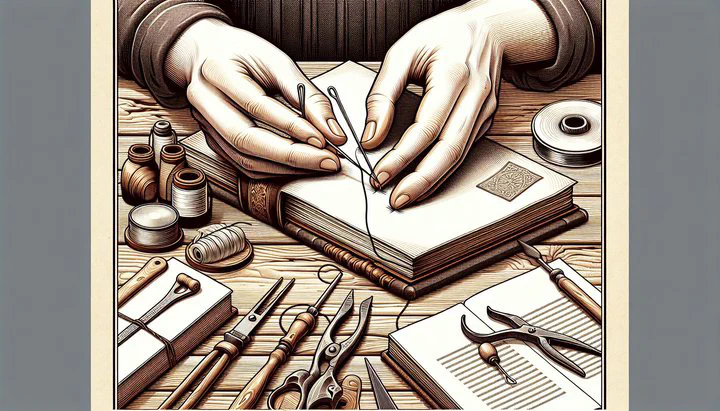Rebinding a Book with Loose Pages

Understanding the Problem
Have you ever picked up a favorite book only to find its spine falling apart or pages slipping out? Many book lovers face this problem, and it can be quite upsetting. Books can deteriorate over time for several reasons. Understanding what’s happening can help you fix these problems and bring your beloved books back to life.
One of the most frequent issues is the spine of the hardcover coming off. This usually happens because of wear and tear. Think of the spine as the backbone of your book. When it’s damaged, the whole book can start to fall apart. It might become loose because of aging, frequent handling, or poor-quality binding materials.
Another problem is pages leaving the glue. This occurs when the adhesive holding the pages together weakens. Over time, glue can dry out and lose its stickiness, especially in a humid or very dry environment. You might notice loose pages or even sections of the book falling out completely.
To fix these issues, it’s essential to understand the causes. Recognizing signs like the spine of the hardcover coming off or pages leaving the glue means you’re ready to take action before your book is too damaged. Let’s explore how to start rebinding a book with loose pages and ensure they stay secure for years to come.
Preparing for Rebinding
Before you can start rebinding a book with loose pages, gather essential materials and tools. Having everything ready will make the process smoother and more enjoyable. Here’s what you’ll need: a sturdy needle, strong thread (like linen), a bone folder, bookbinding glue, a brush, scissors, and a ruler. You’ll also need some bookbinding tape or cloth to reinforce the spine.
An important step in rebinding is lining the back of a textblock. This process is crucial because it strengthens the spine and helps keep all the pages together. Cut your bookbinding tape or cloth to the length of your textblock. Apply a thin layer of glue to the spine and carefully place the tape over it, pressing it down firmly with your bone folder.
Check the condition of the pages before you start. Make sure there are no torn or missing pages. Repair them with a bit of tape or glue. This will ensure that when you rebind them with thread, everything stays in place and looks neat.
By preparing properly, you’ll be ready to tackle the rebinding process with confidence. This preparation not only helps in rebinding a book with loose pages but also ensures your book will be more durable and long-lasting.
Rebinding with Thread
Now that you have your materials ready, it’s time to rebind a book with loose pages using thread. This method is durable and gives your book a classic, handmade look.
First, prepare your book for sewing. Open the book to the middle of the first section where the pages have come loose. Use your ruler to measure about an inch from the top and bottom of the spine and mark these spots lightly with a pencil. These marks will guide you as you pierce holes for the thread.
Next, thread your sturdy needle with strong linen thread. Begin at the top hole on the inside of the spine, pushing the needle through to the outside. Leave a small tail of thread inside and start sewing in a simple in-and-out motion. This is where you start to rebind them with thread, ensuring each stitch is tight. Pull the thread gently but firmly to avoid any slack.
Once you reach the bottom, turn back and sew upwards, filling in the spaces between your original stitches. This creates a zigzag pattern that holds the pages securely. When you reach the top again, tie a secure knot with the tail you left inside at the beginning. Trim any excess thread, but be careful not to cut too close to the knot.
Finally, press the sewn spine gently with your bone folder to ensure the stitches are tight and the pages are aligned. This part of rebinding a book with loose pages is crucial for durability and aesthetics. Patience and precision are key. With these steps, your book will not only be functional but also have a beautiful, handcrafted touch.
Finishing Touches and Maintenance
Congratulations on successfully rebinding a book with loose pages! Now, add some finishing touches to give your book a polished look.
First, focus on finishing the spine. Apply a thin layer of bookbinding glue over the stitched area. This will secure the threads in place. Once dry, cover the spine with bookbinding cloth or tape for added support. Use your bone folder to press the cloth firmly for a smooth finish.
Check the alignment of the pages. Make sure everything looks straight and tidy. If any pages are sticking out, gently press them back into place. Even edges will help keep your book looking professional.
Now that your book is rebound, maintaining it is key. Store your book in a cool, dry place away from direct sunlight. Consider using a book dust jacket or protective cover to shield it from dirt. Regularly dusting your book will keep it looking fresh.
By following these tips, your newly rebound book will look fantastic and be well-protected against future damage. Taking care of your books helps them last longer, so you can enjoy them for many years. The effort you put into rebinding a book with loose pages is an investment in preserving stories and knowledge.
Additional Suggestions:
-
Engagement: Share your own bookbinding experiences in the comments or on our community platforms. We’d love to hear your stories and see your projects!
-
Visuals: Consider adding images or illustrations to accompany each step, making the process easier to follow.
With these tips and techniques, you’re now equipped to breathe new life into your cherished books. Happy crafting!